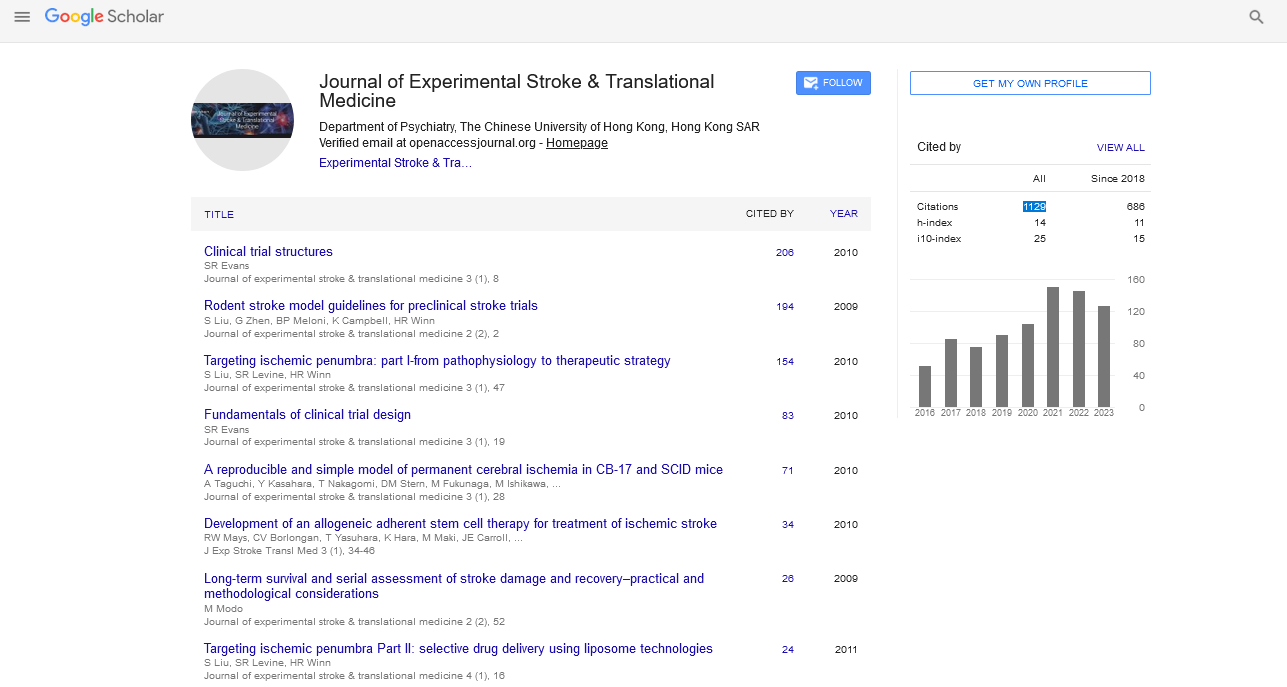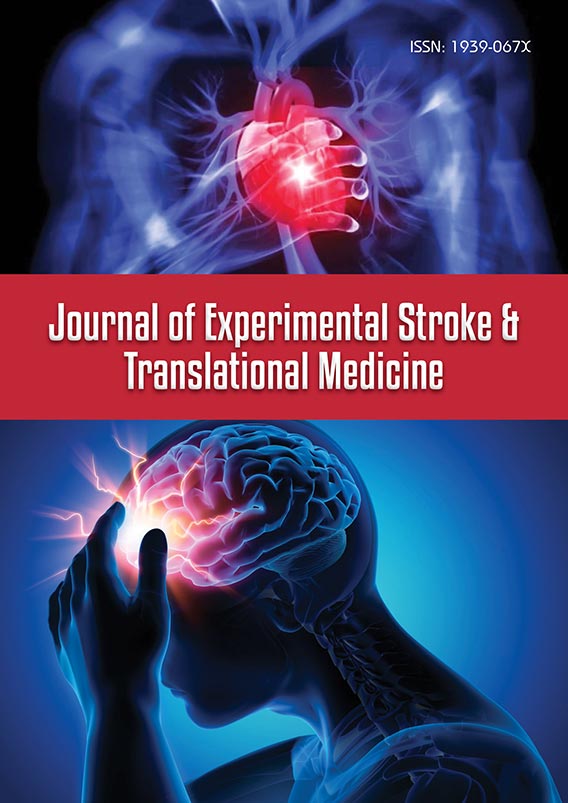Perspective - Journal of Experimental Stroke & Translational Medicine (2025) Volume 17, Issue 1
Beyond the Beat: Atrial Fibrillation and the Intricate Dance of Stroke Causes
Fleming Frd Johansen*
Department of Cardiology, University of Copenhagen, Copenhagen, Denmark
- *Corresponding Author:
- Fleming Frd Johansen
Department of Cardiology, University of Copenhagen, Copenhagen, Denmark
E-mail: xajb@126.com
Received: 27-Nov-2024, Manuscript No. JESTM-23-121192; Editor assigned: 29-Nov-2024, PreQC No. JESTM-23-121192 (PQ); Reviewed: 13-Nov-2024, QC No. JESTM-23-121192; Revised: 14-Feb-2025, Manuscript No. JESTM-23-121192 (R); Published: 21-Feb-2025, DOI: 10.37532/ JESTM.2025.17(1).301-302
Introduction
In the realm of neurological challenges, strokes stand as a formidable adversary, with causes as diverse as the intricate workings of the human body. Among the multifaceted contributors, Atrial Fibrillation (AF) emerges as a significant player, adding a complex layer to the understanding of stroke etiology. This article explores the diverse causes of stroke, with a special focus on the role of atrial fibrillation, unraveling the intricate dance between cardiovascular health and neurological consequences.
Description
Understanding stroke: A complex tapestry of causes
Stroke, often referred to as a “brain attack,” results from a disruption of blood flow to the brain. This interruption can occur through various mechanisms, leading to distinct types of strokes-ischemic and hemorrhagic. Understanding the diverse causes is crucial for prevention, early intervention, and improved outcomes for those at risk.
Ischemic stroke: A closer look
Ischemic strokes, constituting the majority of cases, occur when a blood clot obstructs a blood vessel, preventing oxygen and nutrients from reaching the brain. The causes of ischemic stroke are numerous, ranging from cardiovascular conditions to lifestyle factors that contribute to the formation of these obstructive clots.
Atrial fibrillation: The heart’s chaotic rhythm
Atrial fibrillation, a common cardiac arrhythmia, emerges as a significant contributor to ischemic strokes. In AF, the heart’s upper chambers (atria) quiver or fibrillate instead of contracting effectively, leading to the formation of blood clots. These clots can travel to the brain, causing a blockage in a cerebral artery and triggering an ischemic stroke.
The dance of risk factors
The causes of atrial fibrillation are intertwined with a dance of risk factors, both modifiable and non-modifiable. Age, for instance, is a non-modifiable risk factor, with AF becoming more prevalent as individuals grow older. Other non-modifiable factors include a family history of AF and certain genetic predispositions.
Modifiable risk factors: Lifestyle choices matter
While some risk factors for atrial fibrillation are beyond one’s control, several are influenced by lifestyle choices. High blood pressure, obesity, smoking, excessive alcohol consumption, and a sedentary lifestyle are modifiable risk factors that can contribute to the development of AF. Addressing these factors not only mitigates the risk of AF but also reduces the likelihood of associated ischemic strokes.
Embolic strokes in AF: Unraveling the mechanism
The link between atrial fibrillation and stroke lies in the potential for embolic strokes. As the atria fibrillate, blood may pool, allowing clots to form. When the heart returns to a normal rhythm, these clots can be ejected into the bloodstream, traveling to the brain where they can cause ischemic strokes. This embolic mechanism underscores the importance of managing AF as a preventive strategy against strokes.
Beyond atrial fibrillation: Diverse contributors to ischemic strokes
While atrial fibrillation is a prominent contributor, the causes of ischemic strokes extend beyond this cardiac arrhythmia. Atherosclerosis, the buildup of fatty deposits in the arteries, can lead to the formation of plaques that may rupture and trigger clot formation. Other cardiovascular conditions, such as heart valve disorders and coronary artery disease, also play roles in stroke etiology.
Hemorrhagic stroke: A different beat
In contrast to ischemic strokes, hemorrhagic strokes occur when a blood vessel in the brain ruptures, causing bleeding within or around the brain. Hypertension, or high blood pressure, stands out as a leading cause of hemorrhagic strokes, exerting relentless pressure on the delicate blood vessel walls until they give way.
Intracerebral and subarachnoid hemorrhages: Varieties of bleeding strokes
Hemorrhagic strokes manifest in two primary forms-intracerebral hemorrhage, where bleeding occurs within the brain tissue, and subarachnoid hemorrhage, involving bleeding into the space between the brain and the surrounding membranes. Both varieties have unique causes, with hypertension often serving as a common denominator.
Unraveling the intricacies of hypertension
Hypertension, or high blood pressure, is a silent but potent contributor to strokes. Prolonged elevation in blood pressure weakens blood vessel walls, making them susceptible to rupture. This rupture can result in bleeding within the brain, leading to a hemorrhagic stroke. Managing and controlling hypertension is a cornerstone in stroke prevention efforts.
Beyond cardiovascular causes: Other culprits in stroke etiology
While cardiovascular causes play a pivotal role, strokes can also result from non-cardiovascular factors. Conditions such as diabetes, certain blood disorders, and autoimmune diseases can contribute to stroke risk. Additionally, lifestyle factors, including poor diet, lack of exercise, and smoking, can amplify the overall risk profile for strokes.
Conclusion
In the symphony of stroke causes, atrial fibrillation takes center stage, demonstrating the intricate connection between cardiac health and neurological well-being. Understanding the diverse contributors to stroke etiology, from modifiable lifestyle factors to complex cardiovascular conditions, allows for a synchronized approach to prevention and intervention. As the medical community continues to unravel the complexities of stroke causes, the dance between cardiovascular and neurological health remains a focal point in the quest for improved outcomes and a reduced global burden of stroke.

